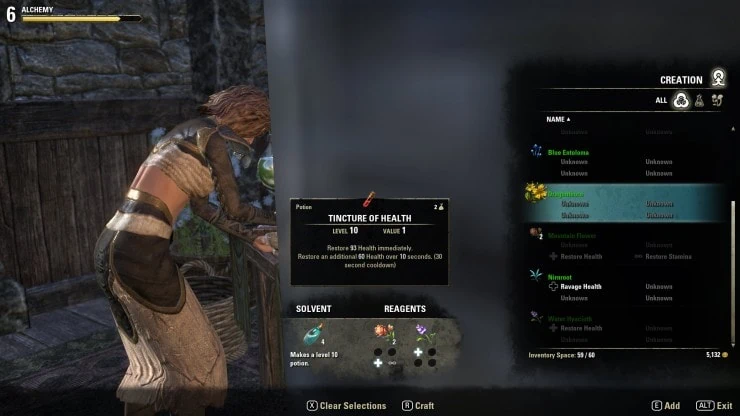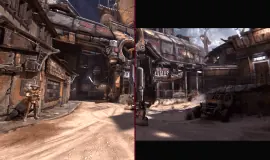Crafting is an essential element of any Elder Scrolls game and ESO is no different. While most MMOs have a fairly simplistic (and boring) crafting system, Elder Scrolls Online managed to create one of the most complex and fun crafting systems found in any MMO to date. There is a total of 6 professions in the game and you can master all six, provided you have enough time and skill points. There are also several addons that help you with your crafting adventure, check out our best ESO addons guide.
Without wasting too much time, let’s dive into all six professions:
- Alchemy
- Blacksmithing
- Clothing
- Enchanting
- Provisioning
- Woodworking
Alchemy
Through Alchemy you can create powerful potions by using different solvents and reagents. The great thing about this system is that you can’t get any recipes – every recipe in the game is discovered by the player, mixing up different ingredients until they produce an effect. Basically, you need a solvent (let’s say Clear Water) and 3 (max) different plants that once combined, will give you a given effect. All ingredients can be found in the world and can be picked up by the player.

As every other profession, Alchemy comes with a set of learnable skills that will allow you to progress further and create powerful concoctions such as health and magicka potions or stamina and invisibility potions. Keep in mind that in the early stages, you won’t be able to see the plants very clearly in the world. However, if you decide that you want to become an Alchemist early on, I’d recommend investing at least 1 point in the Keen Eye: Reagents skill, which will highlight all the plants in a 20/40/60 meter radius, making it very easy to spot them while questing.
Blacksmithing
Blacksmithing allows you to create heavy armors and any weapons besides Bows and Staves, which can be created using the Woodworking profession. However, the profession’s perks don’t end here – you’re able to deconstruct weapons and heavy armors, refine the mined ore, improve your weapons and armors or research various traits. The Blacksmithing profession window comes packed with 5 different tabs:
- Refine – here you can melt your ore into ingots, that will be used in the crafting process
- Creation – in this tab you’ll be able to craft 1h/2h weapons and heavy armors.
- Deconstruct – basically a reverse engineering procedure, melting the given weapon/heavy armor piece into crafting ingredients
- Improvement – using reagents, you can upgrade any given weapon/armor from Normal all the way to Legendary. Keep in mind that upgrading an item from Normal to Fine will require 5 reagents – 20% chance per reagent (Honing Stone in our case), Fine to Superior requires 7 reagents (15% per reagent), Superior to Epic 10% per reagent used and Epic to Legendary only 5%.
- Research – similar to deconstruct, you can melt any weapon/heavy armor to learn its traits. Keep in mind that researching a trait has a 6h cooldown, so you’d want to plan your research accordingly.

Creation
As you can see from the creation window image, creating an item requires you to specify the following:
- Type – 1-hand, 2-hand or any heavy armor piece
- Material – you can specify the ingots type for that specific craft and the number of ingots that you want to use. Using a larger number of ingots will result in a higher level crafted item per extra ingot used.
- Style – here you’ll define the style of the weapon/armor. Initially, you’ll be able to create items in your race’s style but as you progress, you’ll be able to craft any style, provided that you have the reagent for that specific style. Keep in mind that recipes used for learning additional styles drop in barrels and chests, so I’d recommend you don’t skip any in your adventures.
- Trait – remember the traits your researched? Here’s the place to use them in your crafts
As with every other profession, Blacksmithing comes with its own skill set, as you can see here – Blacksmithing Skills. Also, if you plan on going Blacksmithing, we recommend leveling the Keen Eye: Ore skill, which will highlight the ore mines in a 20/40/60 meter radius. Remember that Blacksmithing (along with the other gathering professions) has a passive skill, Hireling, a pseudo-companion that will bring you ore and reagents daily. You won’t be able to see the companion and everything will be sent to you via mail. Also, you should know that if you’re not logging into the game for days, the companion will send you only a day’s worth.
Clothing
Through clothing, you’ll be able to create and improve light and medium armor pieces. The Clothing skill line is identical with the Blacksmith profession, the only difference being that instead of weapons and heavy armors, you’ll be able to craft ONLY light and medium armors. The ingredients from clothing come from world drops/finds and from fibrous plants.
- Refine – here you can refine your found ingredients
- Creation – the main creation panel, allowing you to craft any Light Armor and Medium Armor piece.
- Deconstruct – you can unsew any light & medium armor piece into crafting ingredients
- Improvement – using reagents, you can upgrade any given armor piece from Normal all the way to Legendary. Remember that upgrading an item from Normal to Fine will require 5 reagents – 20% per piece (Hemming in our case), Fine to Superior requires 7 reagents (15% per reagent), Superior to Epic 10% per reagent used and Epic to Legendary only 5%.
- Research – similar to deconstruct, you can destroy any armor piece to learn its traits. Researching a trait has a 6h cooldown, so you’d want to plan your research accordingly.
Creation
Similar to Blacksmithing, creating an armor piece requires you to specify the following:
- Type – Light Armors & Medium Armor pieces
- Material – specify the material for the armor piece and the number of materials that you want to use. Using a larger number of materials will result in a higher level crafted item per extra material used.
- Style – here you’ll define the style of the armor. Initially, you’ll be able to create items in the style of your race but as you progress, you’ll be able to craft any style, provided that you have the reagent for that specific style. Remember that recipes used for learning additional styles drop in barrels and chests, so I’d recommend you don’t skip any in your quests.
- Trait – you can specify the trait you want to use when crafting the armor piece.
Evidently, Clothing comes with its own skill set, as you can see here – Clothing Skills. Evidently, if you plan on leveling Clothing, it’s recommended to level the Keen Eye: Cloth skill, which will highlight the fibrous plants in a 20/40/60 meter radius. Clothing (like Blacksmithing) has a passive skill, Hireling, a pseudo-companion that will bring you ingredients and reagents daily. You won’t be able to see the companion and everything will be sent to you via mail. Also, you should know not logging into the game for days, will only get you a day’s worth of ingredients.
Enchanting
With enchanting, you can create various Glyphs from Runestones found in all around Tamriel. The glyphs will enchant your weapons/armors with different bonuses such as elemental damage, ability cost reductions, health/stamina/magicka and so forth. The Enchanting window has only 2 tabs: Creation and Extraction. The Creation window will show you all the runes that you currently have, with the possibility of sorting them by their type: Potency, Essence or Aspect. The Essence runes can be used at any level while the Potency and aspect require you to level their respective skills: Potency Improvement and Aspect Improvement.
To create a Glyph, you have to combine 3 different runes (from each category) to complete a full Rune Phrase. Similar to Alchemy, you have to match different runes to discover any enchanting recipes. Lastly, the Extraction tab will allow you to disenchant any glyph into runes. All the runes can be found in the world and as always, we recommend investing in Keen Eye: Rune Stones. Also, you should consider that Enchanting has the same companion passive, Hireling, that will bring you runes daily via mail. As with all other hirelings, not logging into the game for days, will get you only a day’s worth of runes.
Provisioning
With the Provisioning profession you’ll be able to create consumables, which will grant different temporary buffs. The main 2 tabs are Cook and Brew, each allowing you to create various food recipes and drinks. Unlike Alchemy and Enchanting, you’ll need to find and learn recipes in order to create any consumables. The recipes are usually found all around Tamriel, in chests, barrels and the occasional drops. The Provisioning skill line also gets a Hireling passive, that will hire a companion to find food or drink ingredients. The ingredients will be sent via mail to you daily.
Woodworking
Woodworking is very similar to Blacksmithing and Clothing, the only difference being that you’ll be able to craft bows, shields and all the staff types: Inferno, Ice, Restoration and Lightning. The raw material used in Woodworking is evidently wood and it can be found all around the world.
- Refine – here you can refine the wood
- Creation – the main creation panel, allowing you to craft any bows, shields or staves.
- Deconstruct – you can disassemble any of your bows, staves or shields into refined wood.
- Improvement – using reagents, you can upgrade any given item from Normal all the way to Legendary. Upgrading a weapon from Normal to Fine will require 5 reagents – 20% per regent used (Pitch in our case), Fine to Superior requires 7 reagents (15% per reagent), Superior to Epic 10% per reagent used and Epic to Legendary only 5%.
- Research – similar to deconstruct, here you can destroy any item to learn its current traits. Researching a trait has a 6h cooldown, so you’d want to plan your research accordingly.
Creation
Creating a bow, shield or staff requires you to choose the following:
- Type – Bow, Shield or Staff Type
- Material – specify the material for the crafted item and the number of reagents that you want to use. The larger number of materials used per craft result in a higher item level.
- Style – define the race style of the crafts. Keep in mind that recipes used for learning additional styles drop in barrels and chests, so I’d recommend you don’t skip any in your adventures.
- Trait – you can specify the trait you want to use when crafting the item.
As always, if you plan on becoming a Woodworker, invest some points in the Keen Eye: Wood – it will highlight the wood in a 20/40/60 meter radius. Woodworking profession has the same hireling passive, Lumberjack Hireling, the companion that will send you wood and possibly other items every day. The companion resets every 24h and all the “found” items will be sent to you via mail. As with all other hirelings, if you don’t log into the game for more than a day, you’ll only get a day’s worth of ingredients.













![[Guide] Enable the hidden ‘Condensed’ display mode on Samsung Galaxy S7 and S6 Enable the hidden 'Condensed' display mode on Samsung Galaxy S7](https://www.bytesin.com/wp-content/uploads/2016/04/Activate-the-hidden-Condensed-display-mode-on-Samsung-Galaxy-S7-120x70.webp)
